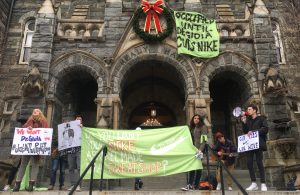Since October, the Georgetown Coalition for Workers’ Rights (GCWR) has pushed for an active presence after a year of struggling with the loss of pre-pandemic momentum. The club advocates for workers’ rights on campus and aims to build solidarity between students and workers. After virtual learning severed student-worker ties, the veteran members of GCWR have made a concerted effort this past fall to reach students for the first time since the return to campus in 2021.
“Last semester was pretty much focused on pulling our coalition back together, rebuilding the infrastructure necessary to organize, maintaining and rebuilding these connections with the workers that used to be as strong as they were before the pandemic,” Josh Gavsie (CAS ’24), one of the leaders of the coalition, said.
The coalition traces its origins to the Georgetown Solidarity Committee (GSC), which held a nationally publicized hunger strike alongside Georgetown employees to protest poor wages in 2005, according to GCWR outreach coordinator Maddie Allen (CAS ’25). The protests led the university to adopt the Just Employment Policy, which remains the standard for Georgetown’s labor practices. When the COVID-19 pandemic started, the GSC disbanded, leading students to form the GCWR to advocate for workers’ demands during the pandemic.
Despite GCWR’s successful campaign to shut down the university’s controversial Redeploy Georgetown program in 2021, which forced non-healthcare workers into public health screening roles at the risk of contracting COVID, the coalition’s leaders returned to campus with little public presence and few connections to the university’s employees. To begin the recovery process, the coalition’s outreach started with the fall 2022 CAB fair to reach potential student activists.
“I saw Josh tabling to the side by himself and he had this random QR code for a group chat, so I joined the group chat,” Fiona Naughton (SFS ’26) said. “The reason that I wanted to join was because I think there’s a really big disconnect between Georgetown University as an institution and the Georgetown community, and I think that’s a really sad part of the student body here.”
The coalition has held several events since October to build connections between students and workers, including evening meetings with facilities workers, a movie night with the Kalmanovitz Initiative for Labor and the Working Poor (KI), and a 5 a.m. donut get-together with the Leo’s staff. The coalition has also established several permanent internal student committees to address workers’ concerns in areas such as facilities, dining, and student organizing.
“We are more in solidarity than I think we have been for the past couple years, and that has allowed us to do a lot more things,” Allen said. “We are planning a lot of community events to have workers and students talk a lot. That’s not something that typically happens on this campus.”
The coalition’s work comes at a time of increasingly strained relationships between the university and its employees. At the beginning of the summer of 2022, the Georgetown Hotel laid off all of its employees without severance pay to make space for additional student housing, despite resistance from the workers and their union.
“That was like a wake-up call for us,” Gavsie said, addressing Georgetown’s controversial decision. “So me and a handful of other students that were really passionate about this issue were just like, ‘We gotta get our shit together and figure something out.’ And that’s when we started putting together the coalition again.”
The challenges Georgetown workers face right now are daunting, including overworking and understaffing.
“There are facilities workers that are responsible for cleaning entire buildings,” Gavsie said. “There are maintenance workers who are backed up on an overwhelming amount of work orders that one person cannot sufficiently tackle.” Many jobs in the facilities department have also been subcontracted to outside workers, he added.
Temporary and part-time workers have also struggled to receive benefits from the university, since they are not being allowed to work enough to qualify for the same treatment as full-time workers, according to Gavsie.
“There are a lot of workers that are being assigned in a way that they’re just barely not hitting the minimum hour threshold that they need to be considered full-time and start receiving benefits,” Gavsie said. “There are also a lot of temp workers that are being brought on but not being made permanent employees.”
To tackle these problems, Gavsie wants the GCWR to strengthen the communication between Georgetown and its workers, particularly through the Advisory Committee for Business Practices (ACBP). The ACBP is the primary body the university uses to monitor, discuss, and negotiate labor issues. Its charter states that it must “assess how best to reflect the University’s commitment to treat all employees as valued members of the Georgetown University community” and ensure fair representation of workers’ interests by including two workers, two students, and one Jesuit as representatives on the committee.
However, the committee hasn’t adhered to many provisions on the charter. The worker and Jesuit representatives are still missing, and Gavsie said the student representatives were added only this winter. He added that even if the two worker representatives were present, they would not be able to adequately represent the myriad of issues plaguing different departments.
The GCWR recently met with the ACBP to stress the importance of improved representation and communication on the committee.
“Our concern was, one, making sure that they’re adhering to those provisions, and two, making the argument that even if those provisions were adhered to, it’s still not enough,” Gavsie said. “So we went in there with the demand of one, you should adhere to your provisions; two, you should expand representation on the committee; and three, you need to keep talking to us.”
Naughton, who became a student representative to the ACBP in December, emphasized the role students play in holding the university accountable to ACBP standards and the power that student voices have to bring about positive action from the university.
“I think that it’s really important to constantly badger the rest of the administrators a little bit to ensure that the workers have secure and responsive union representation,” Naughton said. “As students, we have a lot of power in terms of having our voices heard, and that’s power that the employees on this campus sadly do not always have.”
GCWR is planning an ambitious campaign to foster student engagement in early March with the 2023 Labor Spring, a series of local teach-ins and events about workers’ justice that will take place in high schools, universities, and unions across the nation. Spearheaded by the KI under the guidance of Georgetown professor Joseph McCartin, the 2023 Labor Spring emulates the nation’s first labor spring organized by the AFL-CIO, the nation’s largest trade union federation, in the 1990s. The movement represented a landmark moment for student labor organizing.
“A lot of student organizations, and organizations as a whole, just sprung up in the aftermath of [the AFL-CIO’s] teach-ins,” Allen said. “Our plan is for our Labor Spring event to be an updated version of that.”
In preparation for Georgetown’s own teach-in, which will take place in early March, GCWR has created a fact sheet detailing workers’ conditions across the university to send to the university.
The coalition members plan to discuss the administration’s response to the problems outlined in the sheet, which they hope will attract more student support.
“We’re really looking forward to, at least hoping, that students will get involved with labor organizing at Georgetown,” Allen said. “Because while Georgetown is not great with activism in a lot of senses, labor is one of the areas where students have really taken the initiative.”
Moving forward, GCWR’s members are hopeful about its ability to bring about positive, impactful change for the university’s employees.
“I think that the organization as it stands right now is really well-positioned,” Allen said. “We have built up a lot of good throughways to workers and we have built a lot of friendships with them as well. And I think because of that and also student engagement, we are in a really good place moving forward.”




